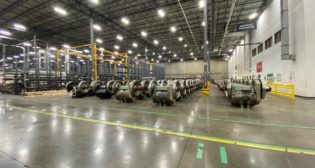
Cummins unveils QSK95 Tier 4 engine; INDR is first customer
Written by William C. Vantuono, Editor-in-Chief“This fully self-contained power module represents the first repower package capable of bringing Tier 4 ultra-low emissions capability to heavy-haul locomotives,” Cummins said. “The QSK95 Power Module is designed to replace the complete diesel-electric system and carbody of the base locomotive as a complete drop-in package. The fully enclosed unit features the QSK95 engine, alternator, cooling system, and dynamic braking system, together with integral Selective Catalytic Reduction (SCR) exhaust aftertreatment specifically designed for locomotives. The clean combustion of the QSK95 works together with Cummins SCR aftertreatment to meet stringent Tier 4 emissions levels.”
The QSK95 Power Module is the result of a design collaboration between Cummins and Sygnet Rail Technologies, LLC, to develop a QSK95 engine with compact and efficient 1,800 rpm high-speed operation. The drop-in power module interfaces with locomotive electronics using standard J1939 engine data bus integration, and features advanced controls for wheel slip functionality, idle limiting, and remote operational reporting.
 Cummins said its latest-generation Modular Common Rail System (MCRS) enables the QSK95 to achieve high fuel efficiency even when operating at maximum-power output for long periods. With up to 2,200-bar high-pressure fuel injection, the MCRS reduces noise, offers smooth idle stability and, eliminates visible smoke across the entire operating range. A quad-turbocharging system with one turbo for each 4-cylinder quadrant provides outstanding response to load demands, with tractive power delivered more rapidly across the entire rpm range to increase acceleration, boost gradient climbing ability, and reduce journey times.
Cummins said its latest-generation Modular Common Rail System (MCRS) enables the QSK95 to achieve high fuel efficiency even when operating at maximum-power output for long periods. With up to 2,200-bar high-pressure fuel injection, the MCRS reduces noise, offers smooth idle stability and, eliminates visible smoke across the entire operating range. A quad-turbocharging system with one turbo for each 4-cylinder quadrant provides outstanding response to load demands, with tractive power delivered more rapidly across the entire rpm range to increase acceleration, boost gradient climbing ability, and reduce journey times.
“The 4,200-hp (3,132 kW) output of the QSK95 prime mover is the highest achieved from a 16-cylinder high-speed diesel, made possible by deep structural strength at the heart of the engine,” Cummins said. “When running at high engine-load factors, the QSK95 powers the locomotive with relaxed ease, operating well within its design capability. High power density is enabled with a hardened power cylinder featuring the strongest, single-piece forged-steel piston available in the industry. This inherent robustness enables the engine to achieve over 20,000 hours on the track before rebuild, without the need for any major midlife intervention. The extra strength components of the QSK95 mean that there is less to replace, so that total life-cycle costs are lower.”
The QSK95 engine and SCR exhaust aftertreatment meet EPA Tier 4 emissions regulations of 0.03 g/bhp-hr Particulate Matter (PM) and 1.3 g/bhp-hr of oxides of nitrogen (NOx) for line-haul locomotives with over 1,006 hp (750 kW) output. Compared with current Tier 3 regulations, this represents more than a 70% reduction. Cummins said it “takes a simpler approach to meeting these stringent levels by putting the main focus of emissions reduction in the exhaust stream, with the SCR aftertreatment removing the NOx. This leaves the engine combustion to focus on removing PM emissions, avoiding the need for any additional complexity on the engine. The SCR aftertreatment has been specifically developed by Cummins Emission Solutions (CES) for locomotive installations, with a space claim similar to that of exhaust silencers, and providing equivalent acoustic reduction. CES experience with SCR is unrivaled in the industry, and has been successfully applied to over 600,000 Cummins engines.”
The Indiana Rail Road’s QSK95-powered freight locomotive—an EMD SD90 currently undergoing refurbishment—will begin revenue service operation by mid-2014. Cummins said the CECX 1919 is expected to be the first heavy-haul locomotive with a repower installation that is Tier 4 compliant. The 95-liter, 16-cylinder prime mover “is one of the most powerful high-speed diesels to be installed in a locomotive,” Cummins said. CECX 1919 will remain under Cummins ownership while operating with the INRD roster. The repowered locomotive will haul coal or mixed freight across the INRD network, over routes from the west and south of Indiana to downtown Indianapolis, typically hauling 100 cars with a total weight of around 14,000 tons, working as the lead locomotive in a multiple set.
Equipped with GPS location and advanced telemetry, CECX 1919 will be remotely monitored by a Cummins field test team taking a continuous stream of locomotive and engine data capture. Based on duty-cycle operational analysis, field test engineers will be able to remotely fine-tune the QSK95 engine to achieve precise improvements in fuel efficiency or power delivery.
The QSK95 engine is being installed in the refurbished locomotive as part of a self-contained drop-in power module, purpose-designed by Sygnet Rail Technologies, LLC, to replace the complete diesel-electric system and carbody. Supplied as a fully enclosed unit, the power module integrates the QSK95 prime mover, SCR exhaust aftertreatment, alternator, cooling system, and dynamic braking as a single package. “This innovative approach for repowering existing locomotives to meet Tier 4 emissions regulations provides for a simpler and faster installation,” Cummins said. “The QSK95 Power Module is tested before installation in the carbody, reducing the time taken to commission the locomotive. Features such as advanced controls for wheelslip, idle limiting, and telematics reporting are integral to the power module.”
“By working together, Cummins and Sygnet Rail Technologies combine the latest in Tier 4 engine technology with a universal drop-in power module that is adaptable for many locomotives independent of original manufacturer, allowing for simpler and faster repowers,” said Cummins High-Horsepower Engine Business Vice President and General Manager Ed Pence. “Cummins high-speed diesels are leading a transformation in locomotive prime mover capability—not only smaller, but powerful, clean, and highly fuel-efficient—equipping the power module with the ability to outperform medium-speed engines. “I am delighted that CECX 1919 will be operating in our home state with the Indiana Rail Road Company, which is widely recognized as one of the most progressive regional railroad companies in North America, and is eager to become one of the first operators to run an ultra-low-emissions locomotive in commercial service. Together with INRD, we are committed to demonstrating the latest locomotive technology using the QSK95 high-speed engine, manufactured in Indiana at Cummins Seymour facility. We believe that our high-speed QSK95 will not just bring cleaner operation, but will achieve higher performance and lower operating costs than INRD has seen before with its traditional medium-speed-powered locomotives.”
“Our SCR exhaust aftertreatment is a passive, flow-through system working together with the clean-combustion QSK95 to meet Tier 4 regulations,” said . By using SCR, we are able to influence the engine combustion formula to optimize fuel efficiency,” Cummins Rail Business Marketing Director Randy Nelson. “In fact, the only real difference with an SCR system compared to exhaust silencers is the requirement for small amounts of Diesel Exhaust Fluid (DEF) dosing to initiate the catalyst and remove the NOx. The fluid is easy to source, store, and handle, with refilling aligned with the locomotive refueling. CECX 1919 will demonstrate how well the clean combustion of the QSK95 engine and Cummins SCR exhaust aftertreatment work together as an integrated system to achieve ultra-low Tier 4 emissions levels, easily accommodating the space claim of the larger medium-speed engine they replace, and requiring no additional cooling capacity.”
The Indiana Rail Road Company is a privately-held, 500-mile railroad based in Indianapolis. The railroad hauls the equivalent of more than 800,000 truckloads of consumer, industrial, and energy products each year. On the strength of its customer service, INRD was awarded Railway Age magazine’s prestigious Regional Railroad of the Year award in 2012.



